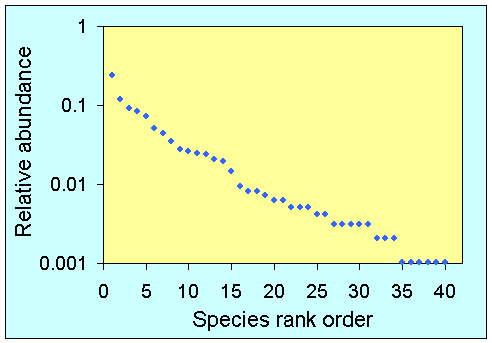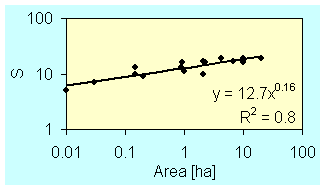Bazy danych
The Internet literature database on species relative abundance distributions
The Internet literature database on species ? area relationships
RAD
Werner Ulrich & Marcin Ollik
The Internet literature database on species relative abundance distributions
 The distribution of species relative densities (the relative abundance distribution or species rank order distribution or dominance rank order distribution) is one of the basic patterns that characterize communities of plant and animal species. Why are only a few species in a community abundant, why are most often many species rare and what factors govern the distribution of abundance and rarity in a community are fundamental questions ecologists have to deal with. It takes therefore no wonder that the study of these distributions had inspired ecologists from the beginnings. The Figure below shows a typical RAD from a community of forest floor spiders (data from Bultmann & Uetz, 1982). Recently, relative abundance distributions gained new interest inspired by the development of ?neutral theories? of species temporal and spatial distribution (Hubbell 1997, 2001, Bell 2001) and by the notion that many macroecological distributions can be studied in terms of self-similarity (Brown et al. 2000, Harte et al. 1999, 2001). However, despite of the many models and theories developed to explain observed community patterns up to now no serious attempt had been undertaken to verify these models on a broad database. Instead, the ecological literature is full of old ?myths? about species density distributions and their causes. Only few attempts had been undertaken (Sugihara 1980, Hughes 1986, Hubbell 2001) to compile data about relative abundances of species and to test models on a broader base.
The distribution of species relative densities (the relative abundance distribution or species rank order distribution or dominance rank order distribution) is one of the basic patterns that characterize communities of plant and animal species. Why are only a few species in a community abundant, why are most often many species rare and what factors govern the distribution of abundance and rarity in a community are fundamental questions ecologists have to deal with. It takes therefore no wonder that the study of these distributions had inspired ecologists from the beginnings. The Figure below shows a typical RAD from a community of forest floor spiders (data from Bultmann & Uetz, 1982). Recently, relative abundance distributions gained new interest inspired by the development of ?neutral theories? of species temporal and spatial distribution (Hubbell 1997, 2001, Bell 2001) and by the notion that many macroecological distributions can be studied in terms of self-similarity (Brown et al. 2000, Harte et al. 1999, 2001). However, despite of the many models and theories developed to explain observed community patterns up to now no serious attempt had been undertaken to verify these models on a broad database. Instead, the ecological literature is full of old ?myths? about species density distributions and their causes. Only few attempts had been undertaken (Sugihara 1980, Hughes 1986, Hubbell 2001) to compile data about relative abundances of species and to test models on a broader base.
Our database is an attempt to change this situation and to provide researchers with a comprehensive commented literature source. The recent version of the database contains more than 500 publications that contain quantitative or at least semiquantitative data sets about protozoan, animal, and plant communities from a local to a continental scale.
Download the Database as an Access file [currently unavailable]
- Bell G. 2000 ? The distribution of abundance in neutral communities ? Am. Nat. 155: 606-617.
- Bell G. 2001 ? Neutral macroecology ? Science 293: 2413-2418.
- Brown J. H., West G. B. 1999 ? Scaling in Biology ? Univ. Press, Oxord.
- Bultmann T. L., Uetz G. W. 1982 ? Abundance and community structure of forest floor spiders following litter manipulation ? Oecologia 55: 34-41.
- Harte J., Kinzig, A. P., Green J. 1999 ? Self-similarity in the distribution and abundance of species ? Science 284: 334-336.
- Harte, J.Blackburn T., Ostling, A. 2001 ? Self Similarity and the Relationship between Abundance and Range Size ? American Naturalist 157: 374-386.
- Sugihara G. 1980 ? Minimal community structure: an explanation of species abundance patterns ? Am. Nat. 116: 770-787.
- Hughes R. G. 1986 ? Theories and models of species abundance ? Am. Nat. 128: 879-899.
- Hubbell S. P. 1997 ? A unified theory of biogeography and relative species abundance and ist application to tropical rain forest and coral reefs ? Coral Reefs 16, Suppl.: S9-S21.
- Hubbell S. 2001 ? The unified theory of biogeography and biodiversity ? Univ. Press, Princeton.
SAR
Werner Ulrich & Mariusz Michalak
The Internet literature database on species ? area relationships
 The species ? area relationship (SAR) is one of the best documented patterns in macroecology (Rosenzweig 1995, Lomolino 2000). It is also one of the few ecological patterns that have practical application. SARs are applied to estimate species loss after habitat destruction (Harte, Kinzig & Green 1999 Ulrich & Buszko 2003, 2005), to identify biodiversity hotspots (Veech 2000, Ulrich 2005), to infer consequences of species introductions and faunal homogenization (McKinney 1998, Rosenzweig 2001, Collins, Vazquez & Sanders 2002), to estimate ß-diversities (Ricotta, Carranza & Avena 2002), or to estimate global biodiversity patterns (Gaston & Hudson 1994, Ulrich 1999).Continental SARs are typically triphasic with a lower (local) concave and an upper (continental) convex shape (Rosenzweig 1995, Hubbell 2001). At intermediate (regional) scales species numbers S most often scale to area A by a power function of the type where S0 is the expected number of species per unit area (the species density) and z a scaling coefficient that ranges frequently between 0.1 and 0.3 (Rosenzweig 1995, Lomolino 2000). Recent theory points to the power function as the general model of SARs (Rosenzweig 1995, Harte et al. 1999) although deviations from this model at different scales occur (Plotkin et al. 2000, Tj?rve 2003, Ulrich & Buszko 2003). However, a critical comparison of published SARs to infer which variables influence the shape of SARs and which models describe the observed patterns best is still missing. There are few compilations of SARs (Connor & McCoy 1979, Rosenzweig 1995) but none of them provides a critical model comparison using recent statistical methods and standards. Hence, the question of what factors shape SARs at different spatial (and temporal) scales is still unsolved.
The species ? area relationship (SAR) is one of the best documented patterns in macroecology (Rosenzweig 1995, Lomolino 2000). It is also one of the few ecological patterns that have practical application. SARs are applied to estimate species loss after habitat destruction (Harte, Kinzig & Green 1999 Ulrich & Buszko 2003, 2005), to identify biodiversity hotspots (Veech 2000, Ulrich 2005), to infer consequences of species introductions and faunal homogenization (McKinney 1998, Rosenzweig 2001, Collins, Vazquez & Sanders 2002), to estimate ß-diversities (Ricotta, Carranza & Avena 2002), or to estimate global biodiversity patterns (Gaston & Hudson 1994, Ulrich 1999).Continental SARs are typically triphasic with a lower (local) concave and an upper (continental) convex shape (Rosenzweig 1995, Hubbell 2001). At intermediate (regional) scales species numbers S most often scale to area A by a power function of the type where S0 is the expected number of species per unit area (the species density) and z a scaling coefficient that ranges frequently between 0.1 and 0.3 (Rosenzweig 1995, Lomolino 2000). Recent theory points to the power function as the general model of SARs (Rosenzweig 1995, Harte et al. 1999) although deviations from this model at different scales occur (Plotkin et al. 2000, Tj?rve 2003, Ulrich & Buszko 2003). However, a critical comparison of published SARs to infer which variables influence the shape of SARs and which models describe the observed patterns best is still missing. There are few compilations of SARs (Connor & McCoy 1979, Rosenzweig 1995) but none of them provides a critical model comparison using recent statistical methods and standards. Hence, the question of what factors shape SARs at different spatial (and temporal) scales is still unsolved.
Our database is an attempt to change this situation and to provide researchers with a comprehensive commented literature source. The recent version of the database contains more than 200 published SARs that contain quantitative data sets about species numbers and areas of protozoan, animal, and plant communities from a local to a continental scale.
Download the Database as an Access file [currently unavailable]
- Collins M. D., Vazquez D. P., Sanders N. J. 2002. Species?area curves, homogenization and the loss of global diversity. Evol. Ecol. Res. 4: 457-464.
- Connor E. F., McCoy E. D. 1979 ? The statistics and biology of the species -area relationship ? Am. Nat. 113: 791-833.
- Harte J., Kinzig, A. P., Green J. 1999 ? Self-similarity in the distribution and abundance of species ? Science 284: 334-336.
- Hubbell S. 2001 ? The unified theory of biogeography and biodiversity ? Univ. Press, Princeton.
- Gaston K. J., Hudson E. 1994 ? Regional patterns of diversity and estimates of global insect species richness ? Biodiv. Cons. 3: 493-500.
- Lomolino M. V. 2000 Ecologist?s most general, yet protean pattern: the species ? area relationship ? J Biogeogr 27: 17-26.
- McKinney M. L. 1998 ? On predicting biotic homogenization: species ? area patterns in marine biota ? Global Ecol. Biogeogr. Lett. 7: 297-301.
- Plotkin J. B., Potts M. D., Yu D. W., Bunyavejchewin S., Condit R., Foster R., Hubbell S., LaFranckie J., Manokaran N., Seng L. H., Sukarmar R., Nowak M. A., Ashton P. S. 2000 ? Predicting species diversity in tropical forests ? Proc. Natl. Acad. Sci. USA 97: 10850-10854.
- Ricotta C., Carranza M. L., Avena G. 2002. Computing ß-diversity from species-area curves. Basic Appl. Ecol. 3: 15-18.
- Rosenzweig M. L. 1995 ? Species diversity in space and time ? Cambridge Univ. Press.
- Rosenzweig. M. L. 2001. The four questions: what does the introduction of exotic species do to diversity? Evol. Ecol. Res. 3: 361-367.
- Scheiner S. M. 2003 ? Six types of species ? area curves ? Global Ecol Biogeogr 12: 441-447.
- Tj?rve E. 2003 ? Shapes and functions of species ? area curves: a review of possible models ? J Biogeogr 30: 827-835.
- Ulrich W. 1999 ? The numbers of species of Hymenoptera in Europe and assessment of the total number of Hymenoptera in the world ? Polish J. Entomol. 68: 151-164.
- Ulrich W. 2005 ? Predicting species numbers using species ? area and endemics ? area relations. Biodiv. Conserv ? 14: 3351-3362.
- Ulrich W., Buszko J. 2003 ? Self-similarity and the species-area relation of Polish butterflies ? Basic Appl. Ecol. 4: 263-270.
- Ulrich W., Buszko J. 2005. Detecting biodiversity hotspots using species ? area and endemics ? area relationships: The case of butterflies. Biodiv. Conserv.14: 1977-1988.
- Veech J. A. 2000 ? Choice of species-area function affects identification of hotspots ? Cons. Biol. 14: 140-147.
This page and the compilation it is based on has been made possible by a grant of the Polish KBN (Nr. 2 P04F 039 29)

 ul. Lwowska 1, 87-100 Toruń
ul. Lwowska 1, 87-100 Toruń![Katedra Ekologii i Biogeografii [fot. Katedra Ekologii i Biogeografii] Katedra Ekologii i Biogeografii [fot. Katedra Ekologii i Biogeografii]](http://www.umk.pl/wiadomosci/serwisy_wp/gallery/1503/medium/KEiB.jpg)